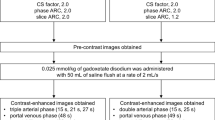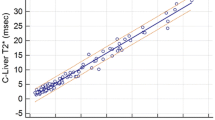Abstract
The performance of breath-hold MR imaging using two T2-weighted hybrid sequences (TSE, TGSE), two T2-weighted single-shot sequences (HASTE, EPI-SE), and one T1-weighted gradientecho sequence (FLASH) was compared with a standard conventional T2-weighted SE sequence in 20 patients with focal liver lesions. Liver signal-to-noise ratio was highest spleen-liver contrast-to-noise ratio (54.3 ± 8.3) and thee HASTE (41.1 ± 12.5) sequence, whereas the highest spleen-liver contrast-noise-ratio was obtained by the TSE sequence (38.9 ± 20.7). Lesion-liver CNR was highest with the TSE sequence (63.9 ± 21.4). With both TSE and HASTE significantly (p < 0.01) more lesions were detected as compared with SE and EPE-SE sequences. Our results indicate that breath-hold TSE and HASTE sequences will eventually replace conventional T2-weighted SE techniques due to their insensitivity to motion artifacts, superior lesion detectability and inherently short acquisitions times.
Similar content being viewed by others
References
Saini S, Modic M, Hamm B, Hahn P (1991) Advances in contrast-enhanced MR imaging. AJR 156: 235–254.
Edelman RR, Wallner B, Singer A, Atkinson DJ, Saini S (1990) Segmented Turbo-FLASH: method for breath-hold MR imaging of the liver with contrast. Radiology 177: 515–521.
Holsinger-Bampton AE, Riederer SJ, Campeau NG, Johnson CD (1991) T1-weighted snapshot gradient-echo MR imaging of the andomen. Radiology 181: 25–32.
Mirowitz SA, Lee JKT, Brown JJ, Eilenberg SS, Heiken JP, Perman WH (1990) Rapid acquisition spin-echo (RASE) MR imaging: a new technique for reduction of artifacts and acquisition time. Radiology 175: 131–135.
Rydberg JN, Lomas DJ, Coakley KJ, Hough DM, Ehman RL, Riederer SJ (1995) Comparison of breath-hold fast spin-echo and conventional spin-echo pulse sequences for T2-weighted MR imaging of liver lesions. Radiology 194: 431–437.
Saini S, Stark DD, Rzedzian RR, Pykett IL, Rummeny E, Hahn PF, Wittenberg J, Ferrucci JT (1989) Forty-millisecond MR imaging of the abdomen at 2.0 T. Radiology 173: 111–116.
Semelka RC, Simm FC, Recht M, Deimling M, Lenz G, Laub GA (1991) T1-weighted sequences for MR imaging of the liver:] comparison of three techniques for single-breath, whole-volume acquisition at 1.0 and 1.5 T. Radiology 180: 629–635.
Winkler ML, Thoeni RF, Luh N, Kaufman L, Margulis AR (1989) Hepatic neoplasia: breath-hold MR imaging. Radiology 170: 801–806.
Listerud J, Einstein S, Outwater E, Kressel HY (1992) First principles of fast spin echo. Magn Reson Q 8: 199–244.
Feinberg DA, Oshio K (1991) GRASE (gradient- and spin-echo) MR imaging: a new fast clinical imaging technique. Radiology 181: 597–602.
Cohen MS, Weiskoff RM (1991) Ultra-fast imaging. Magn Reson Imaging 9: 1–37.
Edelman RR, Wielopolski P, Schmitt F (1994) Echo-planar imaging. Radiology 192: 600–612.
Reimer P, Saini S, Hahn PF, Cohen MS, Brady TJ (1993) Klinische Anwendung der echoplanaren MR-Tomographie in der Detektion fokaler Leberläsionen. RöFo 159: 16–21.
Foley WD, Kneeland JB, Cates JD et al. (1987) Contrast optimization for the detection of focal hepatic lesions by MR imaging. AJR 149: 1155–1160.
Reinig JW, Dweyer AJ, Miller DL, Frank JA, Adams GW, Chang AE (1989) Liver metastases: detection with MR imaging at 0.5 and 1.5 T. Radiology 170: 149–153.
Wittenberg J, Stark DD, Forman BH, Hahn PF, Saini S, Weissleder R, Rummeny E, Ferrucci JT (1988) Differentiation of hepatic metastases from hepatic hemangiomas and cysts by using MR imaging. AJR 151: 79–84.
Bailes DR, Gilderdale DJ, Bydder GM, Collins AG, Firmin DM (1985) Respiratory ordered phase encoding (ROPE) method for reducing respiratory motion artifacts in MR imaging. J Comput Assist Tomogr 9: 835–838.
Bydder GM, Steiner RE, Blumgart LH, Kenia S, Young IR (1985) MR imaging of the liver using short T1 inversion recovery sequences. J Comput Assist Tomogr 9: 1084–1089.
Felmlee JP, Ehman RL (1987) Spatial presaturation: a method for suppressing flow artifacts and improving depiction of vascular anatomy in MR imaging. Radiology 164: 559–564.
Lewis CE, Prato FS, Drost DJ, Nicholson RL (1986) Comparison of respiratory triggering and gating techniques for the removal of respiratory artifacts in MR imaging. Radiology 160: 803–810.
Semelka RC, Chew WM, Hricak H, Thomei E, Higgins CB (1990) Fat-saturation MR imaging of the upper abdomen. AJR 155: 1111–1116.
Reimer P, Ladebeck R, Rummeny EJ, Repp H, Schmitt F, Bongartz G, Schuierer G, Lange T, Peters PE (1994) Initial feasibility studies using single-shot EPI for the detection of focal liver lesions. Magn Reson Med 32: 733–737.
Hahn PF, Saini S, Cohen MS, Goldberg M, Reimer P, Mueller PR (1992) An aqueous gastrointestinal contrast agent for use in encho-planar MR imaging. Magn Rason Med 25: 380–383.
Reimer P, Schmitt F, Ladebeck R, Graessner J, Schaffer B (1993) Evaluation of potential gastrointestinal contrast agents for echoplanar MR imaging. Eur Radiol 3: 487–492.
Goldberg MA, Hahn PF, Saini S, Cohen MS, Reimer P, Brady TJ, Mueller PR (1993) Value of T1 und T2 relaxation times from echoplanar MR imaging in the characterization of focal hepatic lesions. AJR 160: 1011–1017.
Author information
Authors and Affiliations
Additional information
Correspondence to: J. Gaa
Rights and permissions
About this article
Cite this article
Gaa, J., Fischer, H., Laub, G. et al. Breath-hold MR imaging of focal liver lesions: comparison of fast and ultrafast techniques. Eur. Radiol. 6, 838–843 (1996). https://doi.org/10.1007/BF00240685
Received:
Revised:
Accepted:
Issue Date:
DOI: https://doi.org/10.1007/BF00240685




